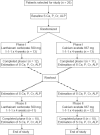Effect of lanthanum carbonate and calcium acetate in the treatment of hyperphosphatemia in patients of chronic kidney disease
- PMID: 20523871
- PMCID: PMC2875739
- DOI: 10.4103/0253-7613.56074
Effect of lanthanum carbonate and calcium acetate in the treatment of hyperphosphatemia in patients of chronic kidney disease
Abstract
Objectives: The tolerability and efficacy of lanthanum carbonate has not been studied in the Indian population. This study was, therefore, undertaken to compare the efficacy and tolerability of lanthanum carbonate with calcium acetate in patients with stage 4 chronic kidney disease.
Design: A randomized open label two group cross-over study.
Materials and methods: Following Institutional Ethics Committee approval and valid consent, patients with stage 4 chronic kidney disease were randomized to receive either lanthanum carbonate 500mg thrice daily or calcium acetate 667 mg thrice daily for 4 weeks. After a 4-week washout period, the patients were crossed over for another 4 weeks. Serum phosphorous, serum calcium, serum alkaline phosphatase, and serum creatinine were estimated at fixed intervals.
Results: Twenty-six patients were enrolled in the study. The mean serum phosphorous concentrations showed a declining trend with lanthanum carbonate (from pre-drug levels of 7.88 +/- 1.52 mg/dL-7.14 +/- 1.51 mg/dL) and calcium acetate (from pre-drug levels of 7.54 +/- 1.39 mg/dL-6.51 +/- 1.38 mg/dL). A statistically significant difference was seen when comparing the change in serum calcium produced by these drugs (P < 0.05). Serum calcium levels increased with calcium acetate (from pre-drug levels of 7.01 +/- 1.07-7.46 +/- 0.74 mg dL), while it decreased with lanthanum carbonate (from pre-drug levels 7.43 +/- 0.77-7.14 +/- 0.72 mg/dL). The incidence of adverse effects was greater with lanthanum carbonate.
Conclusion: Lanthanum carbonate and calcium acetate are equally effective phosphate binders with trends obvious in the first 4 weeks of therapy. The decrease in serum calcium levels with lanthanum carbonate when compared to the increase in serum calcium levels due to calcium acetate is statistically significant. The drawback of lanthanum carbonate is its high cost and relatively higher incidence of adverse events during treatment.
Keywords: Cross-over study; hyperphosphatemia; lanthanum carbonate; phosphate binders; serum phosphorous.
Figures
References
-
- Malluche HH, Monier-Faugere MC. Understanding and managing hyperphosphatemia in patients with chronic renal disease. Clin Nephrol. 1999;52:267–77. - PubMed
-
- Block GA, Port FK. Re-evaluation of risks associated with hyperphosphatemia and hyperparathyroidism in dialysis patients:Recommendations for a change in management. Am J Kidney Dis. 2000;35:1226–37. - PubMed
-
- lock GA, Klassen PS, Lazarus JM, Ofsthun N, Lowrie EG, Chertow GM. Mineral metabolism, mortality, and morbidity in maintenance hemodialysis. J Am Soc Nephrol. 2004;15:2208–18. - PubMed
-
- Goodman WG, Goldin J, Kuizon BD, Yoon C, Gales B, Sider D, et al. Coronary-artery calcification in young adults with end-stage renal disease who are undergoing dialysis. N Engl J Med. 2000;342:1478–83. - PubMed
-
- Eknoyan G, Levin A, Levin NW, National Kidney Foundation Bone metabolism and disease in chronic kidney disease. Am J Kidney Dis. 2003;42:S1–201. - PubMed
LinkOut - more resources
Full Text Sources





